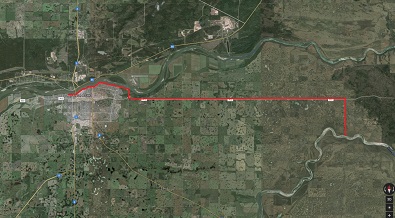Map of new water pipeline being constructed between Prince Albert and South Saskatchewan River.
Husky Energy and Ministry of Environment crews continue their work to clean up as much of the oil spill as they can.
Government officials say crews will be focusing on cleaning up the shoreline from the spill site for a 20-kilometre stretch to Highway 21.
Nine booms have been set up along the river to allow crews to skim oil off the river’s surface.
However, Ministry spokesperson Wes Kotyk admits these booms lose their effectiveness when the oil sheen moves down the river and thins out.
“The nature of the sheen and the way it is moving in the river has caused limited success in being able to recover material on the surface,” said Kotyk. “They are still having those evaluations and may look at continued boom deployment, but at this point they are focused on those areas where they would be the most effective.”
The Environmental Protection branch director also says they will continue to monitor the oil that has moved passed these booms and are currently working on a plan to deal with oil that has dipped below the river’s surface.
Officials say up to this point, 14 wild animals have been killed because of the spill, primarily birds. Another five animals are currently in treatment.
As communities try to find clean sources of water, the final community along the North Saskatchewan River system appears to be in a good spot.
Sam Ferris with the Water Security Agency says Cumberland House should not be threatened by the oil spill.
“They have an off-stream storage reservoir and are working to ensure that reservoir is full,” said Ferris.
Nearly 10,000 people in the Melfort and Prince Albert area are on a boil water advisory.
Residents in Saskatchewan are also reminded to not use the North Saskatchewan River for recreational use specifically in areas impacted by the oil spill.
